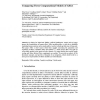Free Online Productivity Tools
i2Speak
i2Symbol
i2OCR
iTex2Img
iWeb2Print
iWeb2Shot
i2Type
iPdf2Split
iPdf2Merge
i2Bopomofo
i2Arabic
i2Style
i2Image
i2PDF
iLatex2Rtf
Sci2ools
PAAMS
2010
Springer
2010
Springer
Comparing Three Computational Models of Affect
In aiming for behavioral fidelity, artificial intelligence cannot and no longer ignores the formalization of human affect. Affect modeling plays a vital role in faithfully simulating human emotion and in emotionally-evocative technology that aims at being real. This paper offers a short expose about three models concerning the generation and regulation of affect: CoMERG, EMA and I-PEFiCADM , which each in their own right are successfully applied in the agent and robot domain. We argue that the three models partly overlap and where distinct, they complement one another. We provide an analysis of the theoretical concepts, and provide a blueprint of an integration, which should result in a more precise representation of affect simulation in virtual humans.
| Added | 20 Jul 2010 |
| Updated | 20 Jul 2010 |
| Type | Conference |
| Year | 2010 |
| Where | PAAMS |
| Authors | Tibor Bosse, Jonathan Gratch, Johan F. Hoorn, Matthijs Pontier, Ghazanfar F. Siddiqui |
Comments (0)

